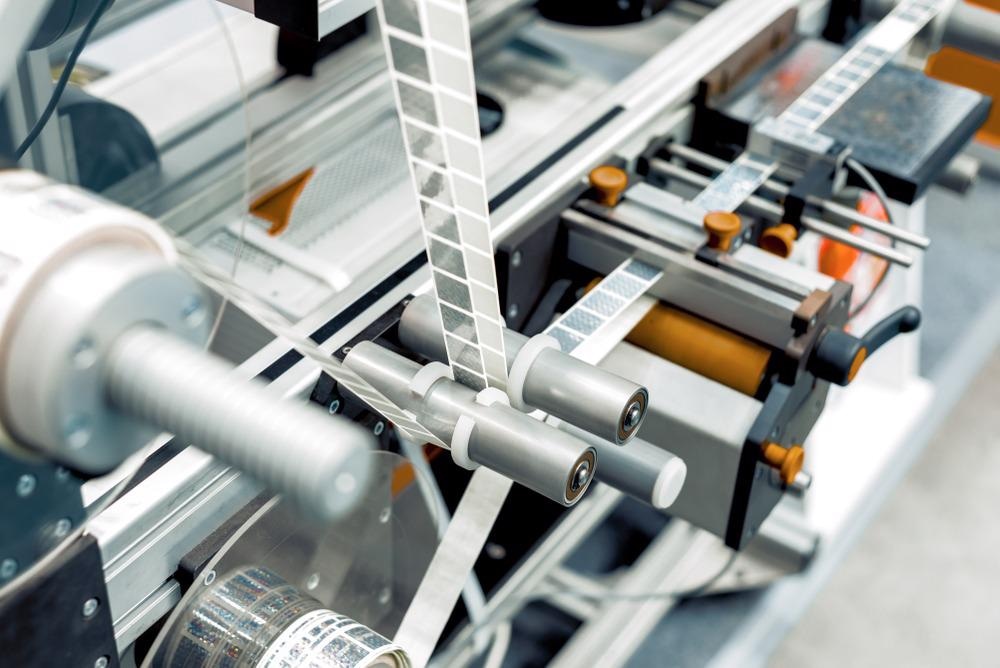
Image Credit: Nordroden/Shutterstock.com
Bringing together the benefits of two scientific concepts for a high degree of versatility, the new GSX sensor from Leuze is the world's first combined fork sensor to blend ultrasonics and light-sensing in a single housing unit.
Commercial packaging often involves applying labels with various shapes, sizes, compositions and textures using labeling machines. In most packaging situations, the precise placement of a label is essential to meeting established standards.
Enabling the precise placement of a label at high conveyor belt speeds, labeling sensors should reliably detect the labels' positions. This is typically done with fork sensors.
How are Fork Sensors Used in Labeling Applications?
In a typical automated manufacturing system, the system must recognize if various product qualities meet requirements.
Fork sensors are the most common kind of sensor used for labeling. Fork sensors' principal advantages include straightforward installation, resistance to the effects of ambient light, and the capability to find difficult label materials.
Fork sensors use a through-beam design involving an emitter and receiver in a singular housing to ensure proper alignment. Fork sensors are usually found in labeling applications to recognize the difference between a label and its carrier material. By either modifying the sensitivity level via potentiometer or using a teach-in function, minor differences between the label and its carrier material can be found.
In addition to being used for packaging, fork sensors can also be used in other manufacturing settings, including detecting small parts and identifying robotic arm positioning.
The First Combined Fork Sensor
The new world’s first combined fork sensor from Leuze merges what are typically two separate sensors: optical and ultrasonic.
The majority of optical fork sensors use light in the infrared part of the spectrum rather than visible light. Although optical devices are adequate in most applications, ultrasonic devices are required for unique packaging designs, typically involving clear packaging, labels, or carrier materials.
The new GSX sensor reliably, swiftly, and accurately detects various labels, despite their composition and surface qualities. Even labels that are notoriously difficult to detect, such as those composed of inhomogeneous cavitated BOPP material, can be detected using the new fork sensors dual detection methods. Therefore, the fork sensor is particularly useful for detecting the positions of a wide range of labels. Previously, this required the usage of multiple sensor units.
The novel GSX forked sensor also has an IO-Link interface to enable the sensor's quick and remote configuration. The interface can also be used to lock the device. The interface allows for simple layout changeovers when switching out rolls. ‘Re-teaching’ is not required when shifting to another label format.
Parameter selection can be carried out directly on the machine. The convenient interface saves setup time and boosts production volume, making an entire packaging system less costly.
Detecting Non-Transparent Labels
For position-accurate placement of opaque labels onto target packaging, labeling sensors must recognize labels on carrier tape. Ideally, a fork sensor can dependably detect labels, even those with unique shapes. The fork sensor should also be simple and easy to set up for just about any label type.
The new fork sensors for labeling applications from Leuze can dependably identify all kinds of non-transparent labels. Usually the job of multiple sensors, the new sensor can handle this task with a singular unit. The new sensor allows for easy set up with either a potentiometer or with the one-button teach function. The slender design and small overall footprint permit the sensors to be set up near the dispensation point.
Detecting Semi-Transparent Labels
For position-accurate placement of semi-transparent labels, it is also vital to effectively identify labels or the gaps between labels. The new GSX fork sensor can readily identify transparent or translucent labels with unusual shapes through the use of ultrasonic technology. This also helps to avoid breakdowns due to inaccurate dispensing. The novel fork sensor can reliably find labels created from inhomogeneous cavitated BOPP material, which is notoriously difficult to detect accurately.
The Bottom Line
For those companies that might use this new technology, the world’s first combined fork sensor can save space, time and costs associated with installation.
The GSX sensor is also ideally suited for labeling machines that regularly change label types, as the dependable detection of all kinds of labels ensures high throughputs and keeps downtime to a minimum. The new sensor provides reliable operation, even in instances of contamination and variation of label materials. This is achieved via automatic reconfiguration of the switching threshold.
With the introduction of this new two-in-one sensor, Leuze has reinforced its reputation as an innovator in this space. The company also invented both the fork sensors for the labeling industry and the first ultrasonic forked sensor.
References and Further Reading
Leuze. Fork sensors for labeling machines used in the packaging industry. [Online] Available at: https://www.leuze.com/en-int
Mepax. Two in one: Leuze presents the GSX, the world's first combined forked sensor. [Online] Available at: https://www.mepax.com/
SICK USA blog. The Benefits of Using Fork Sensors for Label Detection. SICK, Inc. [Online] Available at: https://sickusablog.com/fork-sensors-for-label-detection/
Disclaimer: The views expressed here are those of the author expressed in their private capacity and do not necessarily represent the views of AZoM.com Limited T/A AZoNetwork the owner and operator of this website. This disclaimer forms part of the Terms and conditions of use of this website.